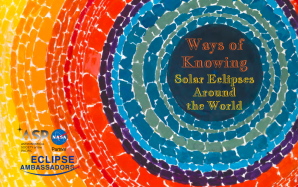5 min read
Scientists Pursue the Total Solar Eclipse with NASA Jet Planes
The April 8, 2024, total solar eclipse will produce stunning views across North America. While anyone along the eclipse path with a clear sky will see the spectacular event, the best view might be 50,000 feet in the air, aboard NASA’s WB-57 jet planes. That’s where a trio of NASA-funded teams are sending their scientific instruments to take measurements of the eclipse.
Two teams will image the Sun’s outer atmosphere – the corona – and a third will measure the ionosphere, the upper electrically charged layer of Earth’s atmosphere. This information will help scientists better understand the structure and temperature of the corona, the effects of the Sun on Earth’s atmosphere, and even aid in the search of asteroids that may orbit near the Sun.
During a total solar eclipse, the Moon perfectly blocks the bright face of the Sun, casting a small swath of Earth in darkness. With the Sun’s main light masked, the much dimmer solar corona becomes visible to the naked eye. This provides scientists a unique opportunity to study this mysterious region of the Sun. The brief blocking of sunlight also allows scientists to study how the Sun’s light affects Earth’s atmosphere.
In the past, solar eclipses have driven numerous scientific discoveries. For this solar eclipse, NASA is funding several scientific experiments – including the three using the WB-57s – to make measurements during the eclipse. NASA’s WB-57s fly much higher than commercial aircraft. This altitude allows the jets to fly above clouds – meaning no chance of missing the eclipse due to bad weather. Additionally, the height puts the jets above most of Earth’s atmosphere, which allows for the cameras to take crisper images and capture wavelengths, such as infrared light, that don’t make it to the ground. Since the planes can travel at 460 miles per hour, they’re also able to extend the time they spend in the Moon’s shadow. While the eclipse will last no more than four and a half minutes at any point on the ground, the planes will see an eclipse that lasts about 25 percent longer, over 6 minutes and 22 seconds.

“By extending the duration of totality, we’re increasing the duration of how much data we can acquire,” said Shadia Habbal, a researcher at the University of Hawaii who leads of one of the WB-57 eclipse experiments.
Habbal’s experiment will fly spectrometers – which record specific wavelengths of light and cameras. The instruments will measure the temperature and chemical composition of the corona and coronal mass ejections, which are large bursts of solar material. With this data, scientists aim to better understand the structure of the corona and identify the source of the solar wind, the constant stream of particles emitted by the Sun.
Habbal hopes the results of their study will help differentiate between different competing models of how the corona is heated. “This light is our best probe short of sticking a thermometer in the corona,” Habbal said.

For another team, led by Amir Caspi at the Southwest Research Institute in Boulder, Colorado, it’s not their first time chasing eclipses by plane. Caspi led a previous trailblazing experiment with the WB-57s during the 2017 total solar eclipse that crossed America from sea to sea. Images taken from the jet were used to study the structure of the corona.
That time was the first the jets had ever been used to study an eclipse. This time, an improved camera setup will allow measurements in more wavelengths from infrared to visible light that will hopefully reveal new information about structures in the middle and lower corona. The observations, taken with a high-resolution, high-speed camera, could also help study a dust ring that circles the Sun and help search for asteroids that may orbit near the Sun.
“There isn’t a lot of data of the Sun at some of the wavelengths we’ll be studying,” Caspi said. “We don’t know what we’ll find, so it’s extra exciting to be making these measurements.”
A third experiment will study the effects of the Moon’s shadow on the ionosphere using an instrument called an ionosonde, which was designed at JHU APL. An ionosonde functions like a simple radar. The device sends out high-frequency radio signals and listens for their echoes rebounding off the ionosphere, which allows the researchers to measure how charged the ionosphere is.
“The eclipse basically serves as a controlled experiment,” said Bharat Kunduri, leader of the ionosphere project and a research assistant professor at Virginia Tech in Blacksburg, Virginia. “It gives us an opportunity to understand how changes in solar radiation can impact the ionosphere, which can in turn impact some of these technologies like radar and GPS that we rely on in our daily lives.”
By Mara Johnson-Groh
NASA’s Goddard Space Flight Center, Greenbelt, Md.
Details
from NASA https://ift.tt/QAGM3Uq









No comments:
Post a Comment